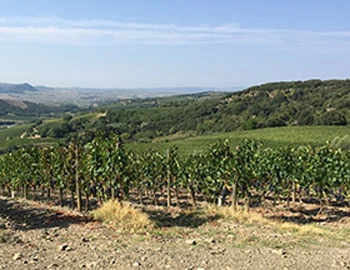Brunello di Montalcino 2019
DOCG, La Gerla, 375 ml

| Grape variety: | Brunello |
| Producer: | Fattoria La Gerla / Sergio Rossi |
| Origin: | Italy / Toscana / Brunello di Montalcino |
| Other bottle sizes: | |
| Other vintages: |
Description
A noble and elegant wine of peerless finesse; undoubtedly a worthy representative of Tuscany. Its bouquet is characterised by spicy aromas reminiscent of truffles, pickled cherries and juniper. Balsamic notes and a hint of fruit compote are wreathed in the scent of myrtle and broom. Fresh and powerful with the taste of dried fruits, it is characterised by a distinctive structure on the palate. It’s worthwhile keeping a few bottles in the cellar, but, to enjoy it at its best, you shouldn’t wait before decanting it.
Attributes
| Origin: | Italy / Toscana / Brunello di Montalcino |
| Grape variety: | Brunello |
| Label: | Vegan |
| Ripening potential: | 5 to 10 years |
| Drinking temperature: | 16 to 18 °C |
| Food Pairing: | Roast saddle of venison, Foie gras, Wild fowl, Wild specialities |
| Vinification: | long must fermentation |
| Harvest: | hand-picking, strict selection |
| Maturation: | in large wooden barrel/foudre |
| Maturation duration: | 36 months |
| Volume: | 14.5 % |
| Note: | Contains sulphites |
Fattoria La Gerla / Sergio Rossi
Standing on La Gerla's terrace, one's view sweeps over Montalcino's peaceful landscape with its hills, vineyards, slim cypresses, and estates scattered all around. Nestled in the Colli Senesi to the south of Siena, the area comprises approx. 2000 hectares (up from just sixty hectares 50 years ago!).
The area is subject to a drier climate than the Chianti region and sees larger differences in temperature between days and nights. The Monte Amiata shields the area from storms approaching from the coast. The sangiovese grosso or brunello, as it is locally known, enjoys optimum maturing conditions. This fosters the development of full-bodied and rather heavy wines full of extract.
La Gerla owns 11.5 hectares, of which 6.5 lie in the northeast, close to Canalicchio, north of the small town of Montalcino. The remaining vineyards lie in the southeast close to Castelnuovo. La Gerla's wines profit from these varied sites. Similarly to the Chianti region, the northern grounds are composed of calciferous marl and are likewise called galestro. Those in the south entail a higher proportion of clay and are partially comprised of volcanic tuff. Thus, the wines created from these differ and complement each other optimally in the finished cuvée.
La Gerla belongs to the lost of renowned and internationally acclaimed estates. Apart from the Brunello di Montalcino we recommend also the Rosso di Montalcino, which is slightly lighter and spends less time developing in the barrel, and the Birba, which ripens in the barrel for about 12 months. Both wines offer earlier drinking enjoyment in comparison to the Brunello. The single vineyard Brunello Gli Angeli is sourced from the eldest vines only in exceptional vintages and destined for long aging. Last but not least, La Gerla's olive oil and their grappa are an excellent complement to the assortment.

Brunello
Epitome of Tuscany
Chianti classico, Brunello di Montalcino, Vino nobile di Montepulciano: the Sangiovese is in each of the classic red wines from Tuscany. For a long time, it was assumed that its birthplace was here. After all, it appeared under various synonyms in Tuscan documents dating from 1600. But in 2004, researchers unveiled that one of its parents originated in Calabria in southern Italy. Today, it is the most planted variety in Italy. In addition to Tuscany, it fares well in Emilia-Romagna, Marche or Umbria. It is an exceptionally lovable wine: its aromas of cherry and plum, violets and spices are complemented by fresh acidity and a juicy texture. It wins people around both as cheerful, drinkable wines with pizza and pasta and as barrel-aged top class wines. Carried by Italian immigrants, it found its way to California and Argentina. However, it does not have the same reputation there.

Italy
Italy – Where wine is a way of life
The Italian wine regions are extremely diverse, and this is made clear in their wines. Established varieties such as Merlot, Syrah, and Sauvignon can be found on just 15 percent of the total vine growing area. The remaining 85 percent is reserved for autochthonous, indigenous varieties. More than 2,000 different grape varieties are grown under diverse conditions and pressed with various techniques into wines that reach the top tier of the international wine market.



